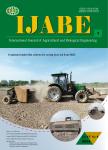Cotton flooding and drought analysis regarding growth stages in Hubei,China,using a daily agrometeorological index
作者机构:School of Civil EngineeringSun Yat-sen UniversityGuangzhou 510275China State Environmental Protection Key Laboratory of Environmental Health Impact Assessment of Emerging ContaminatsyShanghai 200233China State Key Laboratory of Water Resources and Hydropower Engineering ScienceWuhan UniversityWuhan 430072China
出 版 物:《International Journal of Agricultural and Biological Engineering》 (国际农业与生物工程学报(英文))
年 卷 期:2023年第16卷第4期
页 面:173-183页
核心收录:
学科分类:0828[工学-农业工程] 09[农学] 0901[农学-作物学]
基 金:supported by the National Natural Science Foundation of China(Grant No.51861125203,U1911204,and 51909286) the National Key R&D Program of China(Grant No.2021YFC3001000 and 2018YFC1508301).
主 题:irrigation drainage climatic yield waterlogging
摘 要:Cotton yield is restricted worldwide by flooding and drought that occur across various growth stages.In this study,cotton flooding and drought in Hubei(a major cotton-production province in China)from 1961 to 2019 were analyzed regarding growth stages through a daily index named the standardized antecedent precipitation evapotranspiration index(SAPEI).In addition,the impacts of flooding and drought on cotton climatic yield were quantified using multiple regression models.The results showed that the temporal trends of cotton flooding and drought intensities were generally smooth,except for an obvious downward trend for cotton drought intensity at the flowering and boll-forming stage.Additionally,cotton drought intensity varied more drastically than that of flooding over the years.Cotton-flooding proneness was much greater than cotton-drought proneness at all growth stages,and the most flooding-prone and drought-prone periods were identified as the flowering and boll-forming stage and the budding stage,respectively.In terms of spatial distribution,northeastern Hubei and southwestern Hubei were most prone to flooding and drought,respectively.The SAPEI-based regression model(R2=0.490,p0.001),obviously outperforming the SPEI-based model(R2=0.278,p0.05),revealed that both cotton flooding and drought exhibited negatively significant effects on cotton climatic yield and that the yield-reducing effect of cotton flooding was much greater than that of drought.Moreover,when growth stages were further considered using regression analysis,only the flowering and boll-forming stage was detected with a significant yield-reducing effect of cotton flooding.In conclusion,the SAPEI can effectively assist in monitoring cotton flooding and drought;cotton flooding,especially during the flowering and boll-forming stage and that occurring in northeastern Hubei,is the key issue for cotton field water management in Hubei.



